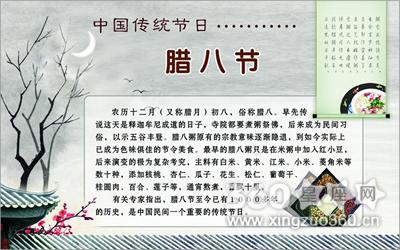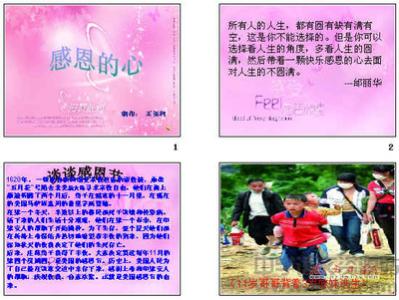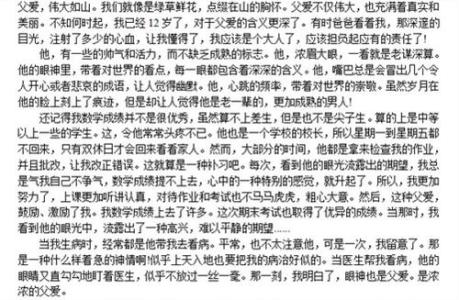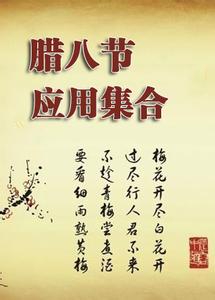关于腊八节
Laba is celebrated on the eighth day of the last lunar month, referring to the traditional start of celebrations for the Chinese New Year. La in Chinese means the 12th lunar month and ba means eight.

Legends about the origin of this festivity abound. One holds that over 3,000 years ago sacrificial rites called La were held in the twelfth lunar month when people offered their preys to the gods of heaven and earth. The Chinese characters for prey and the twelfth month were interchangeable then, and ever since La has been used to refer to both.
Since the festival was held on the eighth day of the Last month, people later appended the number eight (ba in Chinese), giving us the current Laba .
The majority Han Chinese have long followed the tradition of eating Laba rice porridge on the Laba Festival. The date usually falls in mid-January.
腊八节的一天
LaBa morning, get up early, and their brother and sister, and mother in the red laba rice porridge, run to the courtyard, scrambled to feed on every last night at the door of the people on both sides of the ice, with red beans to give him how small mouth, like laughing at the ice of man, the in the mind don't mention how beautiful.
难忘的腊八节
Buddhism was well accepted in the areas inhabited by the Han Chinese, who believed that Sakyamuni the first Buddha and founder of the religion, attained enlightenment on the eighth day of the twelfth month. Sutras were chanted in the temples and rice porridge with beans, nuts and dried fruit was prepared for the Buddha. With the passing of time the custom extended, especially in rural areas where peasants would pray for a plentiful harvest in this way.
There is, however, another touching story: When Sakyamuni was on his way into the high mountains in his quest for understanding and enlightenment, he grew tired and hungry. Exhausted from days of walking, he fainted away by a river in India. A shepherdess found him there and fed him her lunch -- porridge made with beans and rice. Sakyamuni was thus able to continue his journey.
腊八粥的节日
Laba rice porridge contains glutinous rice (糯米), red beans, millet, Chinese sorghum, peas, dried lotus seeds, red beans and some other ingredients, such as dried dates, chestnut meat, walnut meat, almond, peanut, etc. Actually eight ingredients(配料、成分) are used, cooked with sugar to make the porridge tasty.
Northerners prefer to use glutinous rice, red beans, dates, lotus seeds, dried pulp(果肉), walnuts (胡桃), pine nuts and other dried fruits in their porridge; southerners like a salty porridge prepared with rice, soybeans(大豆), peanuts, broad beans, taro, water chestnuts, walnuts, vegetables and diced meat. In the north, it is a dessert with sugar added; in the south, salt is put in. Some people like to add cinnamon and other condiments to add flavor.
Controlling the heat is of great importance in making Laba porridge. At the start, the flame must be high, but the fire is then turned down to let the porridge simmer until it begins to emit a very delicious smell. The process is time-consuming but not complicated.
Laba porridge is not only easy to prepare, but also a nutritious winter food because it contains amino acids, protein, vitamins and other nutrition people need. Cooked nuts and dried fruit are good for soothing nerves, nourishing one's heart and vitality, and strengthening the spleen. Perhaps that is why it is also called babao (Eight Treasure) porridge.
腊八节的趣事
Laba rice porridge was first introduced to China in the Song Dynasty about 900 years ago.
Buddhism was well accepted in the areas inhabited by the Han Chinese, who believed that Sakyamuni the first Buddha and founder of the religion, attained enlightenment on the eighth day of the twelfth month. Sutras were chanted in the temples and rice porridge with beans, nuts and dried fruit was prepared for the Buddha. With the passing of time the custom extended, especially in rural areas where peasants would pray for a plentiful harvest in this way.
There is, however, another touching story: When Sakyamuni was on his way into the high mountains in his quest for understanding and enlightenment, he grew tired and hungry. Exhausted from days of walking, he fainted away by a river in India. A shepherdess found him there and fed him her lunch -- porridge made with beans and rice. Sakyamuni was thus able to continue his journey.
 爱华网
爱华网



